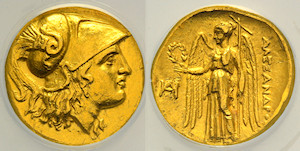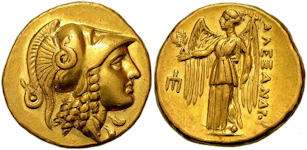Fine Coins Showcase
Antiquities Showcase
Hide empty categories
Shop Search
Shopping Cart
My FORVM
Contact Us
About Forum
Shopping at Forum
Our Guarantee
Payment Options
Shipping Options & Fees
Privacy & Security
Forum Staff
Selling Your Coins
Identifying Your Coin
FAQs
zoom.asp
Home ▸ Catalog ▸ |Greek Coins| ▸ |Hellenistic Monarchies| ▸ |Alexander the Great||View Options:   | | | | | | |


In 279 B.C., Ptolemy Keraunos, the son of Ptolemy I, was captured and killed by Galatian Celts who overran Thrace and established a Celtic kingdom at Tylis. Mesembria, Odessos, Kallatis, and Istros, later followed by Cabyle, Dionysopolis and Tomis began striking gold and silver coins in the name of Alexander the Great along with autonomous civic bronze coinage. Much of the silver and gold coinage was likely needed to pay tribute to the new Celtic rulers of the hinterland until the destruction of the Kingdom of Tylis, c. 218 B.C.SH32292. Gold stater, Price 898 var. (monogram; cf. Price 927 tetradrachm), EF, high relief, bold, mint luster and a rare variety, small scratch on reverse, weight 8.443 g, maximum diameter 18.5 mm, die axis 0o, Kallatis (Mangalia, Romania) mint, c. 250 - 225 B.C.; obverse head of Athena right in crested Corinthian helmet decorated with a coiled snake; reverse Nike standing half left, wreath in extended right hand, stylus in left, KAΛ monogram to left, AΛEΞANΔPOY downward on right; SOLD
Macedonian Kingdom, Alexander the Great, 323 - 317 B.C.


This coin was an early posthumous issue, struck during the nominal rule the puppet kings Philip III (Alexander the Great's brother) & Alexander IV (Alexander the Great's son), under one of the Macedonian satraps in Babylon: Archon, Dokimos, or Seleukos I. The regent Perdiccas suspected Archon of colluding in the theft of Alexander's corpse and, in 321 B.C., sent Dokimos to replace him. Archon was defeated and died from battle wounds. Seleucus, made satrap by Perdiccas' rival Antipater, arrived in Babylon in October or November 320 B.C. and defeated Dokimos.SL111465. Gold stater, Price 3691, Müller Alexander 1271, NGC CH XF, strike 5/5, surface 4/5, fine style (6558782-001), weight 8.569 g, maximum diameter 17.8 mm, die axis 0o, Mesopotamia, Babylon (Hillah, Iraq) mint, early posthumous issue, c. 323 - 317 B.C.; obverse helmeted head of Athena right, crested Corinthian helmet ornamented with a coiled serpent, wearing pearl necklace, M behind; reverse Nike standing left, wreath in right hand, stylus in left hand, BAΣIΛEΩΣ (king) downward on left, AΛEΞANΔPOY (Alexander) downward on right, ΛY low inner right; ex Harlan J. Berk; NGC| Lookup; SOLD
Macedonian Kingdom, Alexander the Great, 336 - 323 B.C.


Troxell did not find links to these dies in the series, but footnote 6, on p. 107, indicates this coin is from series 2. The dies, which match Troxell pl. 24, H, are very similar to Troxell, series 2, pl. 21, 501 (= SNG Sweden II 993) and they were likely engraved by the same hand.SH87557. Gold stater, Troxell pl. 25, H (same dies); SNG Sweden II 993; Price 172; Müller 105; SNG Ashmolean 2522; SNG Cop -; SNG Alpha Bank -; SNG Munchen -, Choice EF, mint luster, some light bumps and marks, weight 8.592 g, maximum diameter 18.7 mm, die axis 135o, Macedonia, Amphipolis mint, struck under Antipater, c. 327 - 325 B.C.; obverse head of Athena right wearing earring, necklace, and crested Corinthian helmet decorated with a coiled snake; reverse Nike standing left, wreath in right hand, stylus in left hand, trident-head downward (control symbol) in left field, AΛEΞANΔPOY downward on right; SOLD
Macedonian Kingdom, Ptolemy I, Satrap of Egypt, 323 - 305 B.C., In the Name of Alexander the Great


In 332 B.C., Alexander the Great marched into Egypt, where he was regarded as a liberator and crowned pharaoh in the Temple of Ptah at Memphis. On either 10 or 11 June 323 B.C., Alexander died in the palace of Nebuchadnezzar II, in Babylon, at age 32. While Alexander's funeral cortege was on its way to Macedonia, Ptolemy I stole Alexander's body and carried it to the heart of the Temple of Ptah, where he had him embalmed by the priests. Alexander's body was laid in a gold anthropoid sarcophagus that was filled with honey, which was in turn placed in a gold casket. Ptolemy claimed that the king himself had officially expressed a desire to be buried in Egypt. More likely, he was motivated by the custom that kings in Macedon asserted their right to the throne by burying their predecessor. Ptolemy II later transferred Alexander's sarcophagus to Alexandria, where a royal tomb was constructed. Ptolemy X Alexander replaced Alexander's gold sarcophagus and casket with glass and stuck coins with the gold. The exact location of Alexander's tomb has been lost.SH68257. Gold stater, Lorber CPE 29 (notes 10 recorded specimens), Svoronos 11, Price 3975, Müller Alexander 6, SNG Cop 643, EF, elegant style, a few light marks, beautiful!, weight 8.554 g, maximum diameter 19.1 mm, die axis 0o, Egypt, Memphis mint, reign of Philip III, c. 318 - 317 B.C.; obverse head of Athena right wearing earring, necklace, and crested Corinthian helmet decorated with a coiled snake, hair in ringlets; reverse Nike standing left, wreath in right hand, stylus in left, thunderbolt left, small ΔI at feet on left, AΛEΞANΔPOY downward on right; ex Gorny & Mosch auction 215 (13 Oct 2013), lot 775; SOLD
Macedonian Kingdom, Alexander the Great, 336 - 323 B.C., Lifetime Issue


In 334 B.C. the Siege of Miletus by the forces of Alexander the Great of Macedonia liberated the city from Persian rule, soon followed by most of Anatolia. Under Alexander, the city reached its greatest extent, occupying within its walls an area of approximately 90 hectares (220 acres). When Alexander died in 323 B.C., Miletus came under the control of Ptolemy, governor of Caria and his satrap of Lydia Asandrus, who had become autonomous. In 312 B.C. Antigonus I Monophthalmus sent Docimus and Medeius to free the city and grant autonomy, restoring the democratic patrimonial regime.SL97494. Gold stater, ADM I series I, 14 (same dies); Price 2077; Müller Alexander 8; SNG Munchen 571; SNG Saroglos 131; HGC 3.1 893f (S); SNG Alpha Bank -, ANACS Extremely Fine EF45 (6275437), weight 8.59 g, maximum diameter 17.9 mm, die axis 345o, Ionia, Miletos (near Balat, Turkey) mint, struck under Philoxenos, c. 325 - 323 B.C.; obverse head of Athena right wearing earring, necklace, and crested Corinthian helmet decorated with a coiled snake, small thunderbolt under neck truncation; reverse Nike standing slightly left, head left, wreath in extended right hand, stylus in left hand, HA monogram left, AΛEΞANΔPOY downward on right; scarce; SOLD
Macedonian Kingdom, Alexander the Great, 336 - 323 B.C.


Possible lifetime issue with beautiful style.SH27864. Gold stater, Price -, Müller Alexander -, cf. Price 2948 ff. for ΔI symbol on tetradrachm and drachm, cf. Price table IX 2957 for style and iconography, EF, weight 8.559 g, maximum diameter 17.5 mm, die axis 180o, uncertain (Side, Pamphylia?) mint, c. 325 - 320 B.C.; obverse head of Athena right in crested Corinthian helmet decorated with griffin; reverse BA-ΣIΛEΩΣ AΛEΞANΔPOY, Nike standing left holding wreath and ship's mast, DI monogram lower left; very rare; SOLD
Macedonian Kingdom, Alexander the Great, 336 - 323 B.C.


Struck during the lifetime of Alexander the Great.SH77066. Gold stater, Price 172, Müller Alexander 105, Choice aEF, mint luster, superb style, high relief, good strike, weight 8.580 g, maximum diameter 18.4 mm, die axis 270o, Macedonia, Amphipolis mint, c. 327 - 325 B.C.; obverse head of Athena right wearing earring, necklace, and crested Corinthian helmet decorated with a coiled snake; reverse AΛEΞANΔPOY, Nike standing left, wreath in right hand, stylus in left hand, trident-head downward (control symbol) in left field; SOLD
Kingdom of Thrace, Lysimachos, 305 - 281 B.C., Portrait of Alexander the Great


SH30334. Gold stater, apparently unpublished, Müller -, EF, sharp details with some luster, obverse slightly double-struck,, weight 8.652 g, maximum diameter 19.5 mm, die axis 0o, uncertain mint, obverse diademed head of Alexander the Great right, wearing the horn of Ammon; reverse BAΣIΛEΩΣ (king) downward on right, ΛYΣIMAXOY (Lysimachos) downward on left, Athena Nikephoros enthroned left, Nike crowning name in extended right hand, left arm rests on grounded round shield decorated with Gorgoneion, transverse spear against right side,
 (AX monogram) left; ex Numismatica Ars Classica (London); SOLD
(AX monogram) left; ex Numismatica Ars Classica (London); SOLDMacedonian Kingdom, Alexander the Great, 336 - 323 B.C.


Born a leader, his genius and charisma led the Macedonian army to create an empire covering most of the then-known world, from Greece to India. His reign begins the Hellenistic Age, a time when civilization flourished. He was regarded as a god and his fame grew even greater after his premature death at thirty-two.SL95868. Gold stater, Price 168a (same dies), Müller Alexander 193, Newell Tarsos 12, HGC 3.1 893a (S), ICG AU80 (1507680109, Tarsos, Pr#3004), Macedonia, Amphipolis mint, struck under Antipater, c. 328/5 - 323/319 B.C.; obverse head of Athena right wearing earring, necklace, and crested Corinthian helmet decorated with a coiled snake; reverse Nike standing slightly left, head left, wreath in extended right hand, stylus in left hand, kantharos left; ICG| Lookup; scarce; SOLD
Macedonian Kingdom, Alexander the Great, 336 - 323 B.C.


Alexander the Great lifetime issue, struck by his Satrap in Lydia, Menander. Menander, the commander of a force of mercenaries in Alexander's army, was appointed by Alexander as the satrap in Lydia in 331. In 323 B.C., he was commissioned to conduct a reinforcement of troops to Alexander at Babylon, where he arrived there just before Alexander's death. In the division of the provinces after the death of Alexander, Menander received his former government of Lydia. He appears soon to have attached himself to the party of Antigonus. In the new distribution of the provinces at Triparadisus in 321 B.C., he lost the government of Lydia, which was given to Cleitus; but this was probably a promotion by Antigonus, as he commanded part of Antigonus' army in the first campaign against Eumenes in 320 B.C. The following year, Menander learned of the escape of Eumenes from Nora, and advanced with an army into Cappadocia to attack him, forcing him to take refuge in Cilicia. After this, no further mention of Menander is found in history.SL96805. Gold stater, Price 2537, Müller Alexander 145, SNG Cop 645, ICG AU50 (2064440108), weight c. 8.5 g, maximum diameter 16.5 mm, die axis 0o, Sardes (Sart, Turkey) mint, lifetime issue, c. 334 - 323 B.C.; obverse head of Athena right, wearing earring, necklace, and crested Corinthian helmet ornamented with a coiled snake; reverse Nike standing half left, wreath in extended right hand, stylus in left, tripod lebes with loop handles (control symbol) to left, AΛEΞANΔPOY downward on right; mint luster that is not captured by the photograph; ICG| Lookup; SOLD

You are viewing a SOLD items page.
Click here to return to the page with AVAILABLE items.
The sale price for a sold item is the private information of the buyer and will not be provided.



REFERENCES
Page created in 1.094 seconds.







